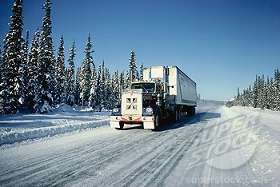Route Planning
Topic 7269 | Page 1
GPS is Good Place to Start.
If co. provided Qualcomm uses recommended route on GPS, check the steps against the Road Atlas. Last week I glanced at it and saw it was putting me on I-4 out of south Florida and assumed it would put me onto I-75 and I took off. Then I realized it put me on I-4 east (I know, I should've double checked) and then it took me up 27 (can you say NIGHT-FREAKING-MARE?!).
If I'd have gone 20 or so miles west on I-4 I could've picked up I-75, stayed at 60mph and saved the company money on fuel and me on time/headaches.
My company says the recommended route is only a recommendation. Plus they tell me GPS only looks forward. So if you're route is facing east, it won't look backwards (west) at a much easier route.
On one trip I looked at the Atlas and saw how close I was to I-64, took that and then up some interstate toward Indianapolis before I ever asked the GPS for the recommended route. It was much smoother sailing than what I knew would be recommended (through every Podunk town).
Qualcomm:
Omnitracs (a.k.a. Qualcomm) is a satellite-based messaging system with built-in GPS capabilities built by Qualcomm. It has a small computer screen and keyboard and is tied into the truck’s computer. It allows trucking companies to track where the driver is at, monitor the truck, and send and receive messages with the driver – similar to email.Interstate:
Commercial trade, business, movement of goods or money, or transportation from one state to another, regulated by the Federal Department Of Transportation (DOT).
DAC:
Drive-A-Check Report
A truck drivers DAC report will contain detailed information about their job history of the last 10 years as a CDL driver (as required by the DOT).
It may also contain your criminal history, drug test results, DOT infractions and accident history. The program is strictly voluntary from a company standpoint, but most of the medium-to-large carriers will participate.
Most trucking companies use DAC reports as part of their hiring and background check process. It is extremely important that drivers verify that the information contained in it is correct, and have it fixed if it's not.
Btw; Google maps is great for switching over to satellite to see what a company entrance may look like before you get there. Did this last week when I was afraid the entry was going to be difficult. Found the Truck Entrance on the satellite and stressed much less on the way in.

1. Company route guide - always place first
2. Rand McNally Atlas - will let you know important and unique info, e.g. low bridges, weight restrictions, etc...
3. Google Maps - does things the Rand Atlas will not, e.g. zoom in to see fine detail at shipper / receiver location, invaluable tool for exit, entrance, and parking strategies
4. My Rand McNally 720 GPS - basically a confirmation tool, gives you a 'head's up' for upcoming exits and junctions, great for smaller roads that have inconspicuous street signs
Running linehaul , I've now gotten to the point where I know most of the locations I can get dispatched to, there's actually quite a bit of them in the northeast. When I first started out, i was going to a 'new' place each dispatch. Besides the company route guide, understanding and using Google Maps and a Rand McNally Atlas was paramount. GPS was used as a confirmation tool.
I believe OTR companies will also provide route guides, or company directions. My experience, and from what I've gathered from other company drivers - always follow the route guide first. There can be mistakes in a company route guide, so you still have to use your head, but more often than not there's a reason they provide the directions, and usually they're spot on.
The Atlas is indispensable for truck specific information, and navigation purposes, and miscellaneous info like rest stops. Plus, if you get the laminated version, you can use an erasable marker and trace your route directly on the map, then just wipe it off for the next trip.
Google Maps - detail to the max. The ability to zoom in is just extremely useful.
GPS. A nice comfort tool. Probably its most useful function is giving you an advance notification of an upcoming street that might not have a conspicuous street sign. Be warned: my 720 has been known to have 'brain farts.' Never trust it completely, use common sense and your company directions.
Shipper:
The customer who is shipping the freight. This is where the driver will pick up a load and then deliver it to the receiver or consignee.
OTR:
Over The Road
OTR driving normally means you'll be hauling freight to various customers throughout your company's hauling region. It often entails being gone from home for two to three weeks at a time.
Linehaul:
Linehaul drivers will normally run loads from terminal to terminal for LTL (Less than Truckload) companies.
LTL (Less Than Truckload) carriers will have Linehaul drivers and P&D drivers. The P&D drivers will deliver loads locally from the terminal and pick up loads returning them to the terminal. Linehaul drivers will then run truckloads from terminal to terminal.
What I like to do is compare the directions that the company gives us with the qualcomm GPS and then look at the atlas to make sure its the best route possible then I use my personal truck GPS for my fuel stop(s) then like everyone else Google maps for the birds eye view of my stop(s) to make sure I know what to look for when arriving at my stops..
Qualcomm:
Omnitracs (a.k.a. Qualcomm) is a satellite-based messaging system with built-in GPS capabilities built by Qualcomm. It has a small computer screen and keyboard and is tied into the truck’s computer. It allows trucking companies to track where the driver is at, monitor the truck, and send and receive messages with the driver – similar to email.
Thanks for the replies guys! Sounds like company directions and the atlas trump gps. I guess I'll be alright without one of those costly gadgets for awhile, at least..
HOS:
Hours Of Service
HOS refers to the logbook hours of service regulations.New Reply:
New! Check out our help videos for a better understanding of our forum features

















Preview:
This topic has the following tags:
Driver Responsibilities GPS Systems Life On The Road







 TT On Facebook
TT On Facebook
It's been said often that a driver cannot rely solely on gps for routing... that it's just one of several tools the driver should use... among them, truckers atlas, google maps, company directions, etc.. I was wondering if some experienced drivers would explain a little about how each of these tools is used in planning your routes. Like, which do you start with, and how do you verify?